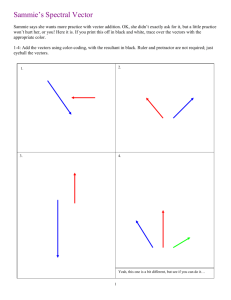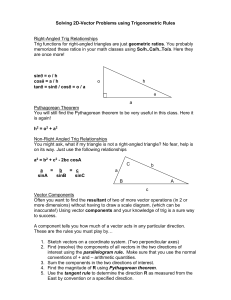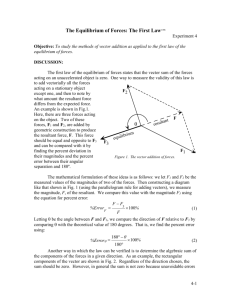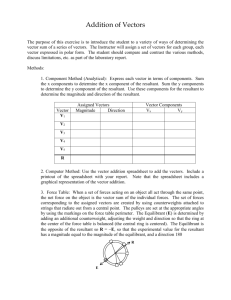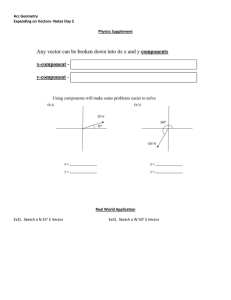Trigonometric Method of Vector Addition
advertisement
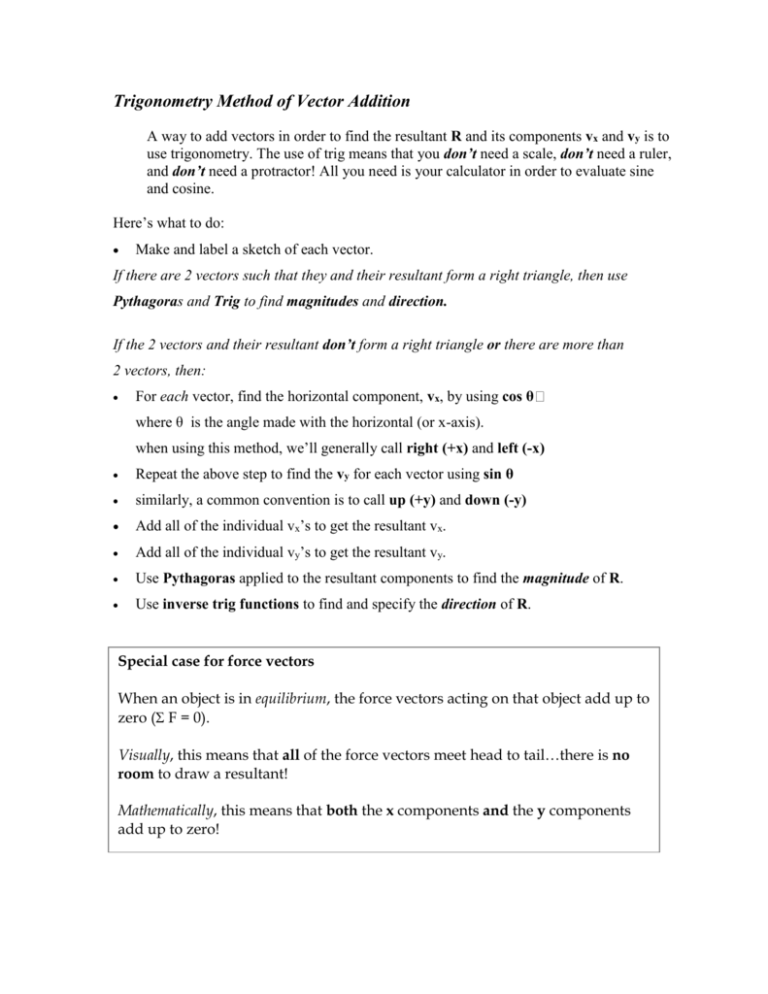
Trigonometry Method of Vector Addition A way to add vectors in order to find the resultant R and its components vx and vy is to use trigonometry. The use of trig means that you don’t need a scale, don’t need a ruler, and don’t need a protractor! All you need is your calculator in order to evaluate sine and cosine. Here’s what to do: Make and label a sketch of each vector. If there are 2 vectors such that they and their resultant form a right triangle, then use Pythagoras and Trig to find magnitudes and direction. If the 2 vectors and their resultant don’t form a right triangle or there are more than 2 vectors, then: For each vector, find the horizontal component, vx, by using cos θ where θ is the angle made with the horizontal (or x-axis). when using this method, we’ll generally call right (+x) and left (-x) Repeat the above step to find the vy for each vector using sin θ similarly, a common convention is to call up (+y) and down (-y) Add all of the individual vx’s to get the resultant vx. Add all of the individual vy’s to get the resultant vy. Use Pythagoras applied to the resultant components to find the magnitude of R. Use inverse trig functions to find and specify the direction of R. Special case for force vectors When an object is in equilibrium, the force vectors acting on that object add up to zero ( F = 0). Visually, this means that all of the force vectors meet head to tail…there is no room to draw a resultant! Mathematically, this means that both the x components and the y components add up to zero! Physics Trig Problems 1. Alex’s horse runs at 20 mph in a direction 58° S of E. Find its components. (vx = 10.5 mph; vy = 17 mph) 2. Scott’s car stalls. Find the components of a push applied if the push is 125 lb in a direction 30° N of E. (vx = 108 lb; vy = 62 lb) 3. TJ is bored and wants to go to the beach. He borrows Alex’s plane and tries to fly east. But a 50 mph southerly wind knocks the plane off course by 17°. Find the plane’s resultant speed and its original speed. (170 mph, 163 mph) 4. Suppose the displacement between your home and WHHS is 4 miles in a direction 48° N of W. What are the components of your displacement from home when you are at school? (vx = 2.7 mi ; vy = 3 mi) 5. Sarah needs the plane to go skiing in Utah. She flies in a southwesterly direction and has a southern component of speed of 200 mph and a resultant speed of 350 mph. Find her western component of speed and exact direction. (vx = 287 mph 55° W of S) 6. A boat tries to cross a stream at 10 m/s. The current downstream is 3 m/s. Find the resultant speed and direction of the boat. 3 m/s 10 m/s (10.4 m/s , 17 S of E) 7. A 60 N force is directed at 30 N of E. A 30 N force is directed at 45 N of E. Find the resultant force. (89 N, 35 N of E) 8. Alex and Kelly go hiking at the Water Gap. Starting at the trailhead, they walk 10 miles at 53 S of W, then 7 miles at 20 N of W. Find their displacement from the trailhead. (13.8 mi, 24 S of W) 9. Katey and Amy come to Scott’s aid. One of them pushes his car with 400 N at 30 N of W. Another pushes west with 340 N. The third pushes with 520 N at 60 S of W. Find their resultant force on the car. (978 N, 15 S of W) 10. Marc’s boat has a top speed of 5 m/s in still water. He is motoring directly east across a river. The current of the river moves south at 3 m/s. Meanwhile a breeze is blowing at 4 m/s in a direction of 30 N of E. Find the boat’s resultant motion. (8.5 m/s, 7 S of E) 11. Three forces act on an object to produce equilibrium, which means that the vector sum of the forces = 0. If one force is 33 N, north and the second force is 44 N at 60 N of E, find the 3rd force needed to produce equilibrium. (note – this 3rd force is known as the equilibrant) (74 N, 73 S of W) 12. Steven, Nora and Michelle push on a crate in such a way as to keep the crate in equilibrium. Steven pushes with a force of 50 N at 40 S of E. Nora pushes with a force of 80 N at 60 N of E. Find the force exerted by Michelle. (86 N, 25 S of W)
